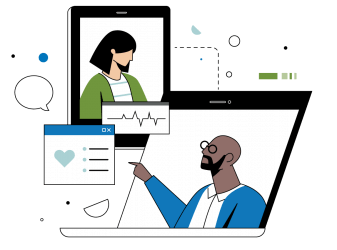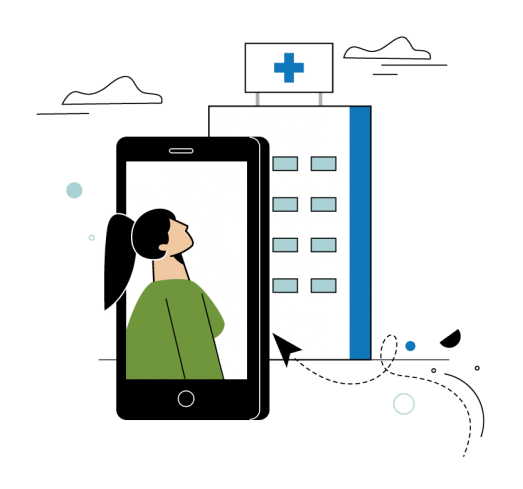
Virtual Visits in Healthcare: The Past, Present, and Future
AVIA
Insights
Betsy Hansen, Director, Center of Consumerism, AVIA

The way consumers interact with businesses has completely changed over the last few years due to advancements in automated, self-service technology like chatbots and text messaging. Companies like Amazon, which use chatbots for questions and returns, or Sephora, where you can message directly with a personal shopper, have revolutionized the way consumers behave, make decisions, and establish loyalty with their favorite brands.
78% of consumers say they want the ability to text with businesses, while 40% of millennials are using chatbots every day. 67% of millennials say they are likely to purchase products or services from a brand that uses chatbots. The market for chatbots has grown exponentially and is expected to continue growing at a rate of 30% per year. Consumers expect the ability to interact with businesses on their terms and through their preferred channels.
Consumers expect the ability to interact with businesses on their terms and through their preferred channels.
While e-commerce, banking, hospitality, and other industries spearheaded these types of digital consumer interactions, healthcare was initially slower to integrate these solutions. However, healthcare organizations have quickly caught on to the power of leveraging text and chat as an automated, personalized, and convenient way of interacting with patients.
For health systems, enabling these types of digital interaction solutions like text and chat are quickly becoming table stakes. 44% of millennials will choose a medical provider because they use mobile digital solutions. Organizations that fail to act will be increasingly unable to meet their consumer needs and risk losing out to competitors who are actively investing in these types of tools. Incorporating text and chat into their patient engagement strategies will enable health systems to better meet the needs and expectations of their patient base and differentiate their service offerings.
Consumer interactions are differentiated, personalized user experience elements that guide a consumer to and through the health system in a series of bi-direction, automated, or live interactions, which generally take place through text and chat on mobile, web, or apps.
Text enables bi-directional conversations between the health system and the consumer through SMS or secure messaging, sent directly to a consumer’s phone. Chat allows similar bi-directional conversations through live, automated, or augmented (live + automated) messages that take place in a chat window on a website or app.
While some health systems have been able to fully scale text and chat solutions across their enterprise, others are just beginning to explore the landscape. In order to gain experience and buy-in needed for a successful implementation, many health systems often start small by selecting one or two high-priority use cases to gain quick wins before scaling more broadly.
There are a number of use cases for health systems to leverage chat and text capabilities. Some common uses health systems start off with include:
Regardless of how health systems decide to roll out text and chat across their organizations, a successful implementation requires deep operational support, robust understanding of the solution landscape, and a clear commitment to integrating these tools into the broader digital strategy.
As health systems expand their consumer interactions strategy, the potential value and opportunity is immense:
Improved patient experience: Text and chat capabilities are a faster, more efficient way for consumers to interact and transact with health systems through their preferred channels. One hospital that implemented texting found that 83% of users were satisfied or extremely satisfied with the solution.
Increased growth for health systems: Chat and text solutions can help drive growth for health systems by increasing appointment bookings. Website visitors are 82% more likely to convert to a patient through texting than through calling or filling out a contact form. One health system saw a 15% increase in appointments after implementing chatbots.
Higher cost savings for health systems: Chat and text solutions can also help to reduce no-shows and improve staff efficiency, leading to cost savings for health systems. One health system found implementing text solutions decreased no-shows by two-thirds, while another increased annual revenue by $1.2 million by creating a text-based no-show campaign.
Though meaningful work is already underway for some in enabling many of the use cases mentioned above, the healthcare industry is still in the early stages of leveraging current capabilities of text and chat. Rapid technological advances in the space make it more difficult for organizations who are late adopters to catch up.
Many text and chat companies are now leveraging AI to not only automate conversations, but also understand, learn, and predict patient needs over time. Some solutions are enabling the ability to string together a series of patient interactions across multiple channels, while remembering the context and history between interactions. For the consumer, this ability creates a hyper-personalized care experience that is integrated, relevant, and can meet them where they are on their care journey. For health systems, this means proactively reaching patients to help resolve their needs more efficiently while deflecting inbound calls to call centers and closing care gaps.
Some examples of future use cases for chat and text include:
As text and chat solutions continue to rapidly evolve, now is the time for healthcare organizations to put digital consumer interactions at the center of their patient experience strategy. There is significant untapped potential for these solutions to make a measurable impact on patient experience and revenue, and health systems who act now will emerge as leaders in the space.
There is significant untapped potential for these solutions to make a measurable impact on patient experience and revenue, and health systems who act now will emerge as leaders in the space.
As your organization explores how to enhance your patient interactions and deploy text and chat solutions across your system, consider the following questions:
If your health system wants to provide a seamless, high-quality experience to patients through digital solutions such as text and chat, AVIA is here to help. Our experts have partnered with over 50 health systems to guide them through building a digital transformation strategy. To learn more, talk to an expert today.
Matthew You, Intern at AVIA’s Center of Consumerism, contributed to this post